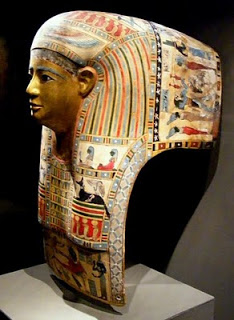Egypt

Copyright Rick Menges, with my thanks
- Photo For Today - Mummy Coffin
Mummy case of Tabes Third Intermediate Period Cartonnage No provenance Here's the description on the website of the Museum of Fine Art, Boston. Mummy case and mummy of Tabes Egyptian, Third Intermediate Period, Dynasty 22, 945–712 B.C. Length:...
- Photo For Today - Pectoral, Mfa
Copyright Rick Menges, with my thanks Here's the text from the Museum of Fine Arts, Boston, website Pectoral Egyptian, Second Intermediate Period, Dynasty 13–17, 1783–1550 B.C. Height x width x depth: 11.2 x 36.5 x 0.5 cm (4 7/16 x 14 3/8...
- Photo For Today - Head From Sarcophagus, Mfa
Copyright Rick Menges, with my thanks Head from an anthropoid sarcophagus Ptolemaic Dynast, c. 200 B.C. Limestone No provenance listed Here's the description from the MFA website: Head from an anthropoid sarcophagus Egyptian, Hellenistic Period...
- Photo For Today - Mfa, Boston
Copyright Rick Menges, with my thanks Lid of the sarcophagus of General Kheperre Late Period, Dynasty 26, reign of Amasis, 570–526 B.C. Giza Greywacke Museum of Fine Arts, Boston Thanks to Rick Menges for rescuing me from the photographic void by...
- Tomb Of Djehutynakht
I have long been fascinated by tomb 10a at El Bersha, the tombs occupant a governor named Djehutynakht was buried in what may be the finest surviving coffin of the Middle Kingdom. His wife in the tomb next to him and what might be the largest collection...
Egypt
Photo for Today - Gilded mummy mask, MFA

Copyright Rick Menges, with my thanks
Mummy Mask
Graeco-Roman
1st Century BC
Museum of Fine Arts, Boston
Museum of Fine Arts
Graeco-Roman
1st Century BC
Museum of Fine Arts, Boston
Museum of Fine Arts
Thanks to Rick for letting me know that, contrary to my previous assertion, the Museum of Fine Arts, Boston, do actually have a database of their collections online. I have no idea how I missed it because I really did do a thorough search for it, but there you go. Senility is obviously setting in. Browsing through the collection, I am impressed with the sheer number of funerary cones they have! The collection as a whole is eclectic and there are some very attractive pieces. The collection search engine, however, leaves a lot to be desired.
Here's what the MFA website has to say about today's photo.
Here's what the MFA website has to say about today's photo.
Mummy mask
Egyptian, Greco-Roman Period, first half of the 1st century A.D., A.D. 0–500
Height: 57.2 cm (22 1/2 in.)
Painted and gilded cartonnage, inlaid glass
Classification: Tomb equipment
On view in the: Egyptian Funerary Arts Gallery
Traditional Egyptian funerary practices continued well into Roman times, when cartonnage mummy masks were made to fit over the head of the wrapped mummy. They belong to the same tradition as mummy masks from the Middle Kingdom. This face, modeled in plaster, is bland and idealized, and represents the deceased transformed into a god. The gilding and glass inlays are quite dazzling. Yet the black hair emerging from beneath the headdress lends a human touch to this shining icon.
The traditional lappet headdress is painted with age-old funerary motifs. A winged sun disk with uraei, image of the celestial Horus, crowns the head like a diadem, and rows of seated deities, Anubis jackals, and solar uraei adorn the sides. The broadcollar is a kaleidoscope of rosettes and geometric patterns imitating rows of beads.
The scene on the chest depicts the resurrection of Osiris. The god reclines on a lion bier, with Isis in front of him and Nephthys behind him, gesticulating with grief and uttering magic spells to bring him back to life. Above him hovers a falcon holding in its talons the shen-ring of eternity and a feather fan. Below are the Red Crown, the Double Crown, and the White Crown — the emblems of his power. Magic seems to take effect before our eyes as the shrouded one, the great god Osiris — his flesh of Nile silt, ram’s horns of divinity on his head — sits up in bed and turns to face his sister-wife. The god is reborn.
Museum of Fine Arts, Boston
Gift of Lucien Viola, Horace L. and Florence E. Mayer Fund, Helen and Alice Colburn Fund, Marilyn M. Simpson Fund, William Francis Warden Fund, and William Stevenson Smith Fund, 1993
Accession number: 1993.555.1
Provenance/Ownership History: By 1993: with Lucien Viola, L'Ibis Gallery, NY; 1993: purchased by the MFA from Lucien Viola.
- Photo For Today - Mummy Coffin
Mummy case of Tabes Third Intermediate Period Cartonnage No provenance Here's the description on the website of the Museum of Fine Art, Boston. Mummy case and mummy of Tabes Egyptian, Third Intermediate Period, Dynasty 22, 945–712 B.C. Length:...
- Photo For Today - Pectoral, Mfa
Copyright Rick Menges, with my thanks Here's the text from the Museum of Fine Arts, Boston, website Pectoral Egyptian, Second Intermediate Period, Dynasty 13–17, 1783–1550 B.C. Height x width x depth: 11.2 x 36.5 x 0.5 cm (4 7/16 x 14 3/8...
- Photo For Today - Head From Sarcophagus, Mfa
Copyright Rick Menges, with my thanks Head from an anthropoid sarcophagus Ptolemaic Dynast, c. 200 B.C. Limestone No provenance listed Here's the description from the MFA website: Head from an anthropoid sarcophagus Egyptian, Hellenistic Period...
- Photo For Today - Mfa, Boston
Copyright Rick Menges, with my thanks Lid of the sarcophagus of General Kheperre Late Period, Dynasty 26, reign of Amasis, 570–526 B.C. Giza Greywacke Museum of Fine Arts, Boston Thanks to Rick Menges for rescuing me from the photographic void by...
- Tomb Of Djehutynakht
I have long been fascinated by tomb 10a at El Bersha, the tombs occupant a governor named Djehutynakht was buried in what may be the finest surviving coffin of the Middle Kingdom. His wife in the tomb next to him and what might be the largest collection...
